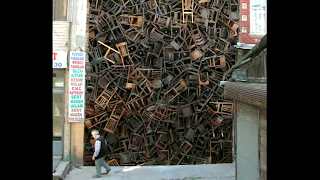1) There are many ways artist can unify their artwork. One way artist unify their artwork is by putting repetition into the artwork. When the artist puts a sense of repetitiveness into their art, they allow the viewer to view their artwork as a unified painting with the designs flowing smoothly. Another way artists' unify their paintings is by applying amplified perspective using contrast of scales to create a sense of depth. When the painting has a sense of depth to the painting it gives the viewer a sense of an actual photo that was taken at that time.

The painting above is called "Awesome Wonder" and it was made by Greg Olsen. This painting is a perfect example of exquisite and balanced unification. The most effective presentation of Jesus was when an old man who was pointing to the 'master' and said, "Behold the man!" When looking at this painting, the viewers get a sense of amplified depth and a sense of warmth and repetition of the trees and the colors. In the end, this painting is a perfect example of a unified painting made by Greg Olsen.
2) An artist creates asymmetrical balance by having an imaginary line in the center of the painting that splits the painting in half allowing the halves to be equally balanced. The painting also has a sense of directional control in which the viewer follows the artists' drawing throughout their artwork. As the artist draw their paintings they wanted to provide a sense of balance with the image being portrayed as well as an giving a sense of direction/ motion.
The painting above was made by Ellen Beauregard for balance. In this painting, Ellen was showing how there is harmony between the circular way the fish move and the way they blend to the watery blue background. The painting was said to be representing balance due to it's creating harmony through the way the artist placed the two fishes.
3) Scale is the size relation of one thing to another. Scale is the most important decision that an artist can make when planning a work of art. Scale can change the way the painting is being viewed by others. When the artist adds scales to the painting it gives the viewer a sense of visual effect.

The painting above was called the "Traditional Chinese Jade Sculpture: the scale of humans in the world". The artist responsible for this sculpture is currently unknown, but according to artsmia.org, website of the Minneapolis Institute of Arts, "This mountain, apparently the largest piece of historic carved jade outside of China, was commissioned in 1784 by the Ch'ien-lung emperor (1736-95) whose own poem appears carved on the backside. The front displays a longer verse, the Lan T'ing Su ("Prelude to the Orchid Pavilion"), a famous poem composed in 353 by Wang Hsi-chi, perhaps the greatest calligrapher of the Far East. The occasion for the poem is illustrated by this jade carving, a literary gathering of poets and scholars organized by Wang at Lan-t'ing, the Orchid Pavilion. Several literati can be seen writing, drinking wine, and collating texts near the Orchid Pavilion at the foot of Mt. Hui-chi." As one can see in this beautifully carved jade sculpture, the artist who carved this sculpture gave us a sense of the scale he/ she used. The artist gives us a sense of the living aspects of the historic civilizations.































